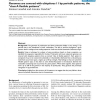148 search results - page 2 / 30 » A computational genomics pipeline for prokaryotic sequencing... |
BMCBI
2008
13 years 6 months ago
2008
Background: Genome survey sequences (GSS) offer a preliminary global view of a genome since, unlike ESTs, they cover coding as well as non-coding DNA and include repetitive region...
BMCBI
2005
13 years 5 months ago
2005
Background: The genomes of prokaryotes and lower eukaryotes display a very strong 11 bp periodic bias in the distribution of their nucleotides. This bias is present throughout a g...
NAR
2007
13 years 5 months ago
2007
The GeneTrees phylogenomics system pursues comparative genomic analyses from the perspective of gene phylogenies for individual genes. The GeneTrees project has the goal of provid...
BMCBI
2007
13 years 6 months ago
2007
Background: The question of how a circle or line segment becomes covered when random arcs are marked off has arisen repeatedly in bioinformatics. The number of uncovered gaps is o...
BMCBI
2011
13 years 14 days ago
2011
Background: Next-generation sequencing technologies allow genomes to be sequenced more quickly and less expensively than ever before. However, as sequencing technology has improve...

